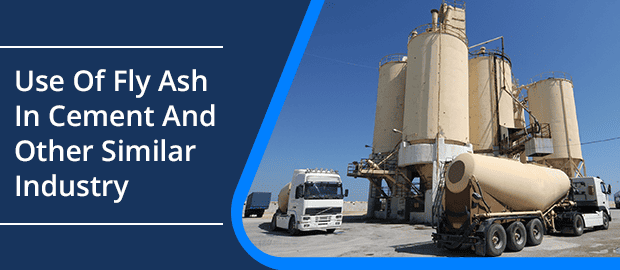The industrial sector is a major contributor to the world’s economic growth; however, it has also been a significant contributor to environmental pollution. One such industry that has a considerable impact on the environment is the cement industry. The demand for cement has constantly been rising, and there is a need to find sustainable alternatives to reduce the environmental impact while ensuring the quality of the product.
An alternative that has been increasingly popular in recent years is the usage of fly ash in cement production. Fly ash and its unique chemical composition is an excellent alternative to cement. Hence the requirement for fly ash handling solutions is on the rise.
As India is the second-largest cement-producing country in the world, the Ministry of Environment, Forest and Climate Change has mandated using at least 25% of fly ash in cement production. Additionally, using fly ash is environmentally beneficial since it can reduce CO2 emissions by up to 30%, as per the data shared by European Coal Combustion Products Association.
In this blog, we will cover what fly ash is, the benefits of using fly ash, as well as different industry-specific uses of fly ash.
Transform Your Cement Business with Fly Ash
A] What Is Fly Ash?
Fly ash is a by-product that is created when coal is burned in order to create electricity. The consistency is like a fine powdery substance that looks like grey or tan dust. Since it is so lightweight, it can float in the air like a cloud. Fly ash comprises a variety of minerals and chemicals including silicon, aluminium, and calcium.
Fly ash is often stored in large piles or ponds, typically close to coal-fired power plants, where the user can be open to various applications. Fly ash is used as a substitute for cement in the construction industry. Mixing fly ash with cement and water can help create a durable, strong, and long-lasting building material. It can also help reduce the amount of cement needed in the construction project. Additionally, it can help to lower construction costs and reduce environmental damage and impact.
Besides the construction industry, fly ash can also be used in soil conditioners for agriculture, in the form of filler material in road construction, and as a component in the production of bricks and concrete blocks.
Although fly ash is safe for use, it can be harmful if not handled properly or disposed of correctly. A fly ash cloud can pose risks to human health, and if mixed with water, it can leach chemicals into soil and water supply. Hence it is imperative to handle and responsibly dispose of fly ash to avoid any potential impacts on the environment and human health.
B] Benefits of Fly Ash
There are multiple benefits associated with the usage of fly ash given below are some of them:
1. Benefits to the environment
Using fly ash in cement reduces carbon emissions, conserves natural resources, reduces waste, improves durability, and reduces water consumption. Fly ash is a byproduct of coal combustion and is used as a partial replacement for Portland cement to reduce the energy required for cement production. This leads to fewer carbon emissions and less use of natural resources. Additionally, using fly ash in cement can improve the strength and durability of the final product, reducing the need for maintenance and repair. Thus using fly ash in cement is a sustainable and environmentally friendly option.
2. Low on cost
Using fly ash in cement can be cost-effective compared to using Portland cement alone. As fly ash is a byproduct of coal combustion, it is usually less expensive than Portland cement. By using fly ash as a partial replacement for Portland cement, the total cost of cement production can be reduced, as less energy is required to produce the cement. Additionally, the use of fly ash in cement can improve the strength and durability of the final product, which can reduce maintenance and repair costs over time.
3. It provides increased durability
Fly ash is a pozzolanic material, which means that it reacts with calcium hydroxide in the presence of water to form additional cementitious compounds. These compounds can help fill up the pores and voids in the concrete, making it dense and reducing the permeability of the material. This, in turn, can help to improve the durability of the concrete, making it more resistant to damage from freeze-thaw cycles, chemical attacks, and abrasion.
4. Improved workability
Fly ash can help improve the workability of cement mixtures. Since it has smaller particle sizes compared to cement, it can be useful in filling gaps and improving the overall smoothness of the mixture. This makes the mixture more workable and easier to place and shape in construction projects.
5. Chemically resistant
When you mix the fly ash into cement mixtures, you also make the mixture more chemically resistant. This happens because fly ash contains minerals and chemicals that can help reduce concrete’s permeability. This can further reduce the effects of chemical erosion and other environmental factors that can contribute to the degradation of concrete.
C] What is Fly Ash Used For?
Following are some of the uses of fly ash in allied industries where fly ash can be utilized:
1. Construction industry
Since fly ash can act as an excellent substitute for cement, it is widely used in the construction industry. The use of fly ash in cement increases the durability and strength of the mixture. It can also help reduce the amount of cement needed for a particular construction project. The use of fly ash in cement industry can reduce costs and carbon footprints in construction as well.
2. Agriculture
Fly ash can be utilized in agriculture as a form of soil conditioner. It has a unique chemical composition that can help improve soil fertility and increase crop yields. It can also help neutralize acidic soils and reduce soil erosion.
3. Road Construction
Fly ash can be utilized as a filler material in road construction. It can be helpful in improving the strength and durability of the surfaces of roads. This can further prevent cracking and other forms of wear and tear.
4. Land Reclamation
With its unique chemical composition, fly ash can be used for land reclamation. It can help to neutralize acidic soils and also improve soil fertility. This makes it ideal for restoring damaged or contaminated land.
5. Brick production
Fly ash can be used as an important component in the production of bricks and concrete blocks. The use of fly ash in bricks helps reduce the dependence on cement in production and eventually results in cost savings. Fly ash brick industry usage can also help increase the strength and durability of the final product.
Transform Your Cement Business with Fly Ash
Conclusion
In conclusion, the use of fly ash in cement and other industries has become an increasingly popular and sustainable option. As a byproduct of coal combustion, fly ash would otherwise have to be disposed of, making its use a more eco-friendly option. Fly ash offers a range of benefits, including cost savings, increased durability, and improved workability, making it an ideal alternative to traditional cement in the construction industry. It is also used in other industries, such as agriculture, road construction, brick and block production, and land reclamation.
However, it is important to note that fly ash needs to be handled using the right types of ash handling conveyors and disposed of responsibly to avoid any potential negative impacts on the environment and human health. Therefore, it is crucial to regulate fly ash’s production, handling, and disposal to ensure that it is used safely and sustainably.If you are considering the best ash handling system manufacturer in India, look no further than Macawber.



